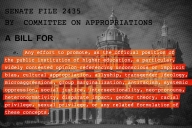You have /5 articles left.
Sign up for a free account or log in.

Istockphoto.com/SV_SUNNY
A new study shows that minority and first-generation students have a higher sense of belonging at two-year colleges than their counterparts at four-year institutions.
Researchers who conducted the study also found that while racial-ethnic minority and first-generation students at four-year institutions are less inclined to feel that same sense of belonging, first-year students at both two-year and four-year colleges and universities said they "somewhat agree" that they belong on their campuses. The students rated their experiences on campus using a "belonging scale" of one to five with four representing that they "somewhat agree" they feel a sense of belonging.
A report about the study, published Dec. 24, was written by Maithreyi Gopalan, an assistant professor of education at Pennsylvania State University, and Shannon Brady, an assistant professor of psychology at Wake Forest University. They used a nationally representative sample compiled by researchers at the U.S. Department of Education and examined student sentiments at two- and four-year institutions.
“We wanted to see if students' reported sense of belonging toward the end of their first year in college is predictive of some of the outcomes that colleges really care about,” Gopalan said. She noted outcomes such as persistence in the second and third years of college and mental health.
“We find that underrepresented ethnic minority students and first-generation students do report a lower sense of belonging than continuing-generation students or white students,” Gopalan said of the findings at four-year institutions. “The difference is not dramatically big -- it is pretty small -- but there is this difference which I think institutions should pay attention to.”
One of the motivations for the study was other research findings that minority and first-generation students report a lower sense of belonging, said Brady. She said that the new findings presented a more nuanced picture than what is often portrayed.
At four-year institutions, a better sense of belonging among students leads to higher rates of personal and academic successes later in their college experiences, the researchers said. Students who report a higher sense of belonging at the end of the first year seem to do better than their counterparts. The authors found that those students seemed to be persisting more in their second and third years, as well as reporting lower levels of mental health issues.
“We find experimentally trying to help people foster a sense of belonging can improve a number of positive outcomes. We have found benefits on academic outcomes, benefits on health outcomes, benefits on engagement types of outcomes,” said Brady. “And what we know is that those are the kinds of outcomes that individuals care about, and also that colleges care about. We hope that this research really helps colleges think critically about how they’re going about their efforts to foster students’ sense of belonging on campus.”
When underrepresented student populations do not feel a strong sense of belonging on their campus, it impacts how they integrate, perform and persist, Gopalan said.
Across all institution types, students at two-year institutions report a lower sense of belonging over all, but underrepresented minority and first-generation students are the exceptions. Gopalan said she wonders if this is because underrepresented minority and first-generation students tend to be represented in higher numbers at two-year institutions.
Another difference the report's authors found between students at four-year and two-year institutions was that students at four-year institutions who felt a higher sense of belonging were more likely to utilize campus services such as student advising and financial aid services than those at two-year colleges. Gopalan believes students who use these services are more likely to persist through their second and third years of college.
“For students in two-year colleges, they may certainly face more structural barriers,” Brady said. “We know from other research that for students at two-year colleges they are often more likely to be balancing family and another job -- or possibly both. We know they can have greater challenges with access to needed financial aid. But it may be for many of those students the sort of relevant question is not ‘do I belong in this school?’ in general but possibly ‘do I belong in this major?’ or ‘do I belong in this class?’”
“We are not making any causal interpretation because we can’t do that with our research design and the methods that we used, so this is purely correlational,” said Gopalan. She noted that students self-reported their sense of belonging and other outcomes.
“One of the reasons why we wrote this paper is to highlight that we need to have better measures in national data sets like this that can capture students’ sense of belonging, but also more detailed measures of what kind of services they use,” Gopalan said. “Do they use more of a particular kind of service? What kind of students use what kind of services more?”
Efforts by colleges and universities to pinpoint and increase minority and first-generation students' sense of belonging have grown over the past few years as a way to improve retention rates and diversity.
A student’s sense of belonging on campus is under increased scrutiny as more studies emphasize its importance. A 2018 study showed that more colleges are recognizing first-generation students at their time of application and tracking their progress, and an increasing number of four-year colleges are implementing programs to assist those students.
First-generation students lagged behind multigenerational students in resiliency and social comfort, and opinions vary on how best to support this population. The percentage of first-time students enrolled in community college who identify as Hispanic increased from 13 percent to 26 percent from 2001 to 2016, according to the American Association of Community Colleges.
“We know from other studies that student advising, institutions, faculty, advisers -- all of them have to make an effort to reach out to students who feel like they don’t belong and provide attention as well as services to ensure that all students can integrate on campus,” Gopalan said.
To address this disparity of minority and first-generation students who don’t feel as if they belong on campus, Gopalan said that institutions should have faculty and role models of color so students don’t feel alienated. She said institutions should provide these students with strong advising services and culturally relevant pedagogy and messaging. Gopalan also said that solutions differ by institution and context is key in improving sentiments of belonging.
While some institutions might find it tempting to resort to just telling students, "you belong here," Brady said that outreach efforts need to go deeper to be effective. This includes helping students face challenges and setbacks and better understand course grading and having trustworthy mentors and faculty available on campus. She said it is beneficial to connect students with other students and faculty to improve their sense of belonging.
Brady also noted that reports of especially low levels of sense of belonging early on are extremely predictive of student persistence later. She encouraged institutions to focus on students who start at that the lower end of the scale, as they are at greater risk of poor outcomes.








